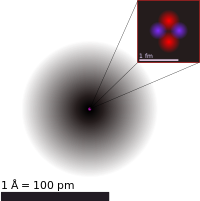
Photo from wikipedia
Two new complexes [FeIII(Tp)(CN)2(μ-CN)MnIICl(HL1)]·3DMF (1) and {[FeIII(Tp)(CN)(μ2-NC)2CuII(HL2)](ClO4)}2·6DMF (2) (HL1 = 2-((((1-methylbenzimidazol-2-yl)methyl)(pyridin-2-ylmethyl)amino)methyl)phenol and HL2 = 2-(((pyridin-2-ylmethyl)(quinolin-2-ylmethyl)-amino)methyl)phenol) have been synthesized and characterized by elemental analysis and IR and UV/vis spectroscopy. Structural analysis… Click to show full abstract
Two new complexes [FeIII(Tp)(CN)2(μ-CN)MnIICl(HL1)]·3DMF (1) and {[FeIII(Tp)(CN)(μ2-NC)2CuII(HL2)](ClO4)}2·6DMF (2) (HL1 = 2-((((1-methylbenzimidazol-2-yl)methyl)(pyridin-2-ylmethyl)amino)methyl)phenol and HL2 = 2-(((pyridin-2-ylmethyl)(quinolin-2-ylmethyl)-amino)methyl)phenol) have been synthesized and characterized by elemental analysis and IR and UV/vis spectroscopy. Structural analysis revealed that 1 is a discrete dinuclear coordination complex and 2 is a discrete tetranuclear coordination complex. In complex 1, each MnII is in a distorted octahedral MN4OCl environment where coordination is satisfied by three nitrogen atoms and one oxygen atom of the ligand, and a chloride group and one nitrogen atom from cyanide. In complex 2, each Cu is in a distorted octahedral MN5O environment where coordination is satisfied by three nitrogen atoms and one oxygen atom of the ligand, and two nitrogen atoms from two cyanides. Direct current (dc) variable-temperature magnetic susceptibility measurements on polycrystalline samples of 1 and 2 were carried out in the temperature range of 1.8-300 K. Investigation of the magnetic properties reveals the occurrence of weak antiferromagnetic coupling between the low-spin FeIII (S = 1/2) ions and high-spin MnII (S = 5/2) ions in 1, while 2 exhibits ferro- and antiferromagnetic coupling between the metal ions in the tetranuclear CuII2FeIII2 unit. DFT calculations show ferromagnetic coupling in both complexes, although this appears to be weak in the case of complex 1. In addition, magnetostructural correlations reveal the magnetic behavior against Mn-N-C and Fe-C-N angles in 1 and Cu-N-C and Fe-C-N angles in 2.
Journal Title: Dalton transactions
Year Published: 2023
Link to full text (if available)
Share on Social Media: Sign Up to like & get
recommendations!